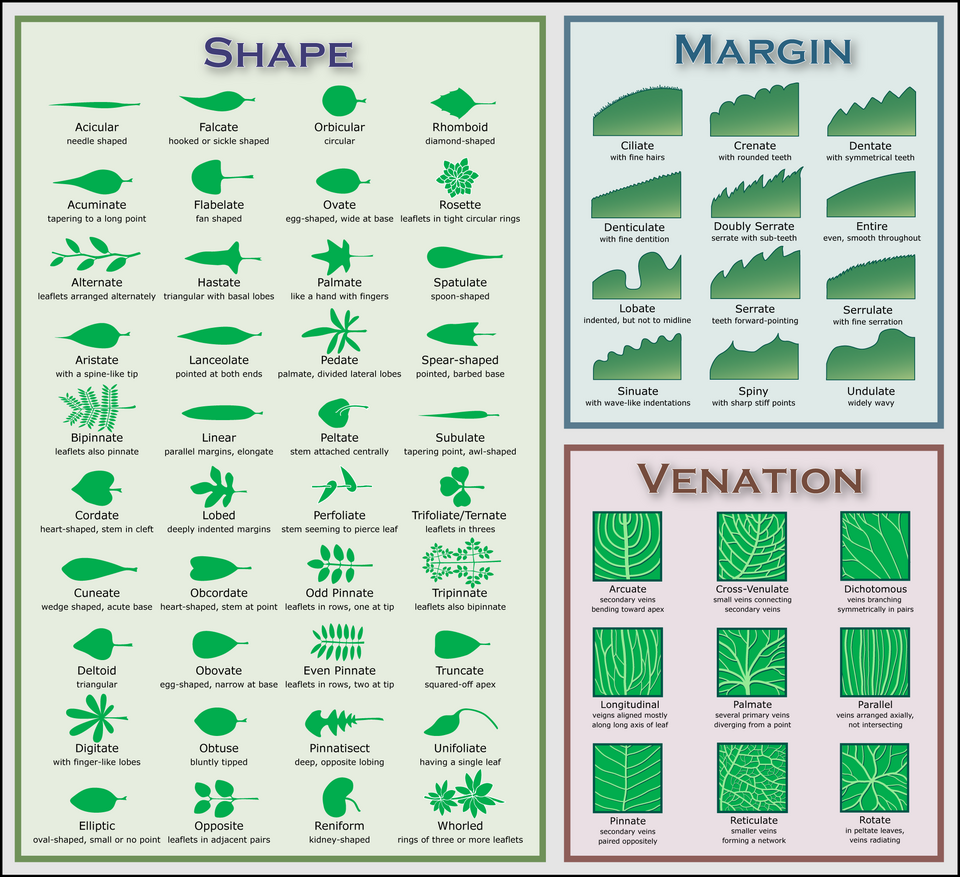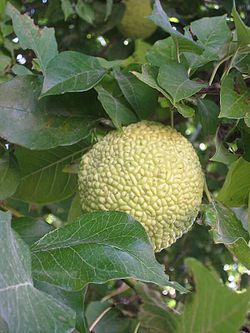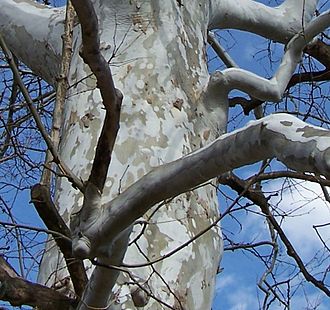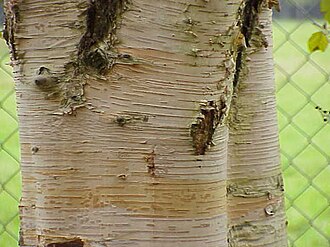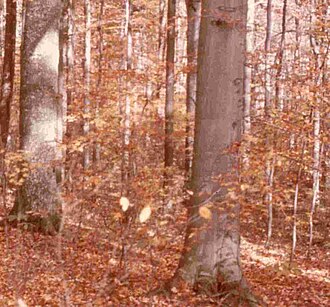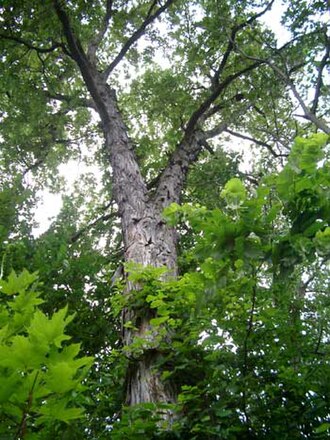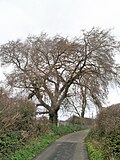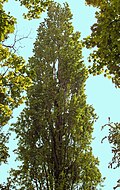Difference between revisions of "AY Honors/Trees - Advanced/Answer Key"
| Line 97: | Line 97: | ||
==8. Define the following terms:== <!--T:14--> | ==8. Define the following terms:== <!--T:14--> | ||
| − | + | ===a. Stipule=== | |
| − | + | Outgrowths on either side of the petiole. | |
| − | + | ===b. Petiole=== | |
| − | + | A leaf's stem. | |
| − | + | ===c. Blade=== | |
| − | + | The flat portion of a leaf, the blade may simple or be divided into leaflets (compound). | |
| − | + | ===d. Pitch=== | |
| − | + | Pitch is the name for any of a number of highly viscous liquids which appear solid. Pitch can be made from petroleum products or plants. Pitch produced from plants is also known as resin. | |
| − | + | ===e. Heartwood=== | |
| − | + | Examination of the cross-section of a log will reveal dark wood near the center, and light-colored wood near the bark. The dark wood near the center is heartwood. As a tree increases in age and diameter an inner portion of the sapwood becomes inactive and finally ceases to function, as the cells die. This inert or dead portion is called heartwood. | |
| − | + | ===f. Sapwood=== | |
| − | + | Sapwood is comparatively new wood, comprising living cells in the growing tree. All wood in a tree is first formed as sapwood. Its principal functions are to conduct water from the roots to the leaves and to store up and give back according to the season the food prepared in the leaves. | |
| + | ===g. Springwood=== | ||
| + | The inner portion of a growth ring is formed early in the growing season, when growth is comparatively rapid (hence the wood is less dense) and is known as "early wood" or "spring wood" | ||
| + | ===h. Summerwood=== | ||
| + | The outer portion of the growth ring is the "late wood" (and has sometimes been termed "summerwood", often being produced in the summer, though sometimes in the autumn) and is more dense. | ||
| + | ===i. Annual ring=== | ||
| + | Annual rings can be seen in a horizontal cross section cut through the trunk of a tree. Visible rings result from the change in growth speed through the seasons of the year, thus one ring usually marks the passage of one year in the life of the tree. The rings are more visible in temperate zones, where the seasons differ more markedly. | ||
| + | ===j. Cambium=== | ||
| + | A layer of cells just under the bark of a tree. This layer is only one cell deep, and it produces all the new wood in a tree. | ||
| + | ===k. Xylem=== | ||
| + | A vein in a tree that brings water from the roots into the leaf. | ||
| + | ===l. Phloem=== | ||
| + | A vein in a tree that moves sap out, the latter containing the glucose (a form of sugar) produced by photosynthesis in the leaf. | ||
==9. What families of trees have:== <!--T:15--> | ==9. What families of trees have:== <!--T:15--> | ||
| − | + | ===a. Thorns=== | |
| − | + | Hawthorn, locust | |
| − | + | ===b. Catkins=== | |
| − | + | Oak, birch, willow, alder, poplar | |
| − | + | ===c. Winged seeds=== | |
| − | + | Maple, ash, elm | |
| − | + | ===d. Acorns=== | |
| − | + | Oak | |
| + | ===e. Pods=== | ||
| + | Locust (and other legumes), mimosa | ||
| + | ===f. Capsules=== | ||
| + | Sourwood, paulownia, eucalyptus | ||
| + | ===g. Nuts=== | ||
| + | Hickory, beech, birch, walnut | ||
| + | ===h. Berries=== | ||
| + | Yew, mulberry, elderberry, nannyberry | ||
==10. Identify ten deciduous trees by their “winter” characteristics, (features other than leaves) such as twig and bud, characteristic form, and growth habits.== <!--T:16--> | ==10. Identify ten deciduous trees by their “winter” characteristics, (features other than leaves) such as twig and bud, characteristic form, and growth habits.== <!--T:16--> | ||
Revision as of 03:50, 8 November 2020
1. Have the Trees Honor.
For tips and instruction see Trees.
2. Collect, identify, press, and mount leaves of 35 different species of trees.
Adventist Youth Honors Answer Book/Leaf collection
3. Separately collect, press, mount, and label specimens that demonstrate the following terms:
a. Serrate
The margins of the leaf have forward-pointing teeth. (cherry)
b. Doubly serrate
Each serration on the margin of the leaf has smaller serrations of its own. (elm)
c. Entire
The entire margin of the leaf is smooth. (sassafras, pawpaw, osage orange)
d. Crenate
The margins of the leaf have rounded teeth. (beech)
e. Dentate
The margins of the leaf have symmetrical teeth. (chestnut)
f. Lobe
The margins of the leaf have large, smooth indentations that do not go all the way to the centerline. (oaks)
g. Incise
The margins of the leaf are deeply and sharply cut. (Maples)
h. Whorled
Three or more leaves are attached to a single node on a branch or stem.
i. Opposite
Leaves are paired on a node on opposite sides of the stem. (sumacs, hickorys, walnut)
j. Alternate
Only a single leaf grows from a node.
k. Pinnately compound
A leaf consisting of multiple leaflets. (sumac, locust)
l. Triple compound (if possible)
Like pinnately compound leaves except the leaflets have leaflets of their own. (devil's walking stick, mimosa).
4. Complete the following
4a. Describe the advantages in using the Latin or scientific names.
Latin names (such as Quercus alba which is white oak) are useful because they are absolutely unique for each species. Thus, the Latin name can be used in international settings without ambiguity. Sometimes a given species will go by one name on one region, and by another name in another region.
For example, the Osage-orange (Maclura pomifera) is also known as mock orange, hedge-apple, horse-apple, hedge ball, bois d'arc, bodark (in Texas), and bow wood. A common slang term for it is also monkey brain or monkey ball due to its brainlike appearance.
Bows are made from many types of wood, including yew and red elm, so "bow wood" could mean any of these. However, Maclura pomifera means only one thing.
4b. Of what use are the two parts of a scientific name?
The first part of the scientific name is the genus, and the second part is the species. We have already discussed Quercus alba - the white oak, so let's expand on that. There are many, many different species of oak, and they are all in the genus Quercus. All these trees produce acorns, and they are closely related to one another. Grouping them into a common genus recognizes their similarities, while separating them by species recognizes their differences.
5. Name six families of trees in the angiosperm class and three families in the gymnosperm class.
Angiosperms
- Beech Family
- Beeches, Chestnuts, Chinkapins, and Oaks
- Birch Family
- Alders, Birches, Hornbeams, and Hazelnuts
- Cashew Family
- Smoketree and Sumacs
- Custard-Apple Family
- Pawpaw and Pond apple
- Elm Family
- Elms and Hackberries
- Horsechestnut Family
- Buckeyes and Horsechestnuts
- Laurel Family
- Laurels, Redbay, and Sassafras
- Legume Family
- Acacias, Redbuds, and Locusts
- Magnolia Family
- Magnolias, and Yellow (Tulip) Poplar
- Maple Family
- Maples
- Mulberry Family
- Figs, Mulberries, and Osage Oranges
- Palm Family
- Coconuts, Dates, Palms, and Palmettos
- Rose Family
- Apples, Peaches, Pears, and Plums
- Sycamore Family
- Sycamores
- Walnut Family
- Hickories, and Walnuts
- Willow Family
- Aspens, Poplars, and Willows
Gymnosperms
- Cedar or Cypress Family
- Cedars, Cypresses, Junipers
- Pine Family
- Firs, Hemlocks, Pines, and Spruces
- Redwood Family
- Redwood, Giant Sequoia, Baldcypress
- Yew Family
- Yews, Torreyas
6. Know and describe the function of leaves in the life of a tree.
A leaf is the part of a plant specialized for photosynthesis. For this purpose, a leaf is typically flat and thin, to expose the cells containing chloroplast to light over a broad area, and to allow light to penetrate fully into the tissues. Leaves can store food and water.
7. Name the families of trees in your area which have opposite leaves.
This is a partial list of trees with opposite leaves. There may be more in your area.
Maples, most Dogwoods, Ashes, Buckeyes, Buckthorn, Redwood, Paulownia, Lilac, Viburnum, Juniper, Black Mangrove, Olive, Piratebush, Boxwood, Southern Catalpa, Eucalyptus (gum), Pomegranate, and Elderberry.
8. Define the following terms:
a. Stipule
Outgrowths on either side of the petiole.
b. Petiole
A leaf's stem.
c. Blade
The flat portion of a leaf, the blade may simple or be divided into leaflets (compound).
d. Pitch
Pitch is the name for any of a number of highly viscous liquids which appear solid. Pitch can be made from petroleum products or plants. Pitch produced from plants is also known as resin.
e. Heartwood
Examination of the cross-section of a log will reveal dark wood near the center, and light-colored wood near the bark. The dark wood near the center is heartwood. As a tree increases in age and diameter an inner portion of the sapwood becomes inactive and finally ceases to function, as the cells die. This inert or dead portion is called heartwood.
f. Sapwood
Sapwood is comparatively new wood, comprising living cells in the growing tree. All wood in a tree is first formed as sapwood. Its principal functions are to conduct water from the roots to the leaves and to store up and give back according to the season the food prepared in the leaves.
g. Springwood
The inner portion of a growth ring is formed early in the growing season, when growth is comparatively rapid (hence the wood is less dense) and is known as "early wood" or "spring wood"
h. Summerwood
The outer portion of the growth ring is the "late wood" (and has sometimes been termed "summerwood", often being produced in the summer, though sometimes in the autumn) and is more dense.
i. Annual ring
Annual rings can be seen in a horizontal cross section cut through the trunk of a tree. Visible rings result from the change in growth speed through the seasons of the year, thus one ring usually marks the passage of one year in the life of the tree. The rings are more visible in temperate zones, where the seasons differ more markedly.
j. Cambium
A layer of cells just under the bark of a tree. This layer is only one cell deep, and it produces all the new wood in a tree.
k. Xylem
A vein in a tree that brings water from the roots into the leaf.
l. Phloem
A vein in a tree that moves sap out, the latter containing the glucose (a form of sugar) produced by photosynthesis in the leaf.
9. What families of trees have:
a. Thorns
Hawthorn, locust
b. Catkins
Oak, birch, willow, alder, poplar
c. Winged seeds
Maple, ash, elm
d. Acorns
Oak
e. Pods
Locust (and other legumes), mimosa
f. Capsules
Sourwood, paulownia, eucalyptus
g. Nuts
Hickory, beech, birch, walnut
h. Berries
Yew, mulberry, elderberry, nannyberry
10. Identify ten deciduous trees by their “winter” characteristics, (features other than leaves) such as twig and bud, characteristic form, and growth habits.
By bark
The bark of many trees is easily recognizable, and in some cases, using the bark to identify the tree is easier than using the leaves.
- Sycamore
- The bark of a sycamore tree could best be described as "patchy." Large scales of the outer brown, gray, and white bark flake off to reveal a green bark beneath. Sycamores are most often found near streams, rivers, ponds, or other sources of water.
- Paper Birch
- The bark of the paper birch is white, commonly brightly so, flaking in fine horizontal strips, and often with small black marks and scars. It is papery, with thin wisps peeling off. The tears in the bark run laterally, and there are characteristic "dotted lines" running in the same direction.
- Beech
- Beech trees are similar to birch trees, but the bark does not peel off in paper-thin wisps. Also, the color is a bit more grey, and it lacks the horizontal "dotted lines" found on the birch.
- Dogwood
- The bark of a mature dogwood breaks up into small scales.
- Hackberry
- The bark of the hackberry tree is warty. These warts are typically .25 inches (6 mm) in diameter, and arranged in groups on the tree's trunk.
- Hornbeam
- The bark of the hornbeam (also known as ironwood) looks distinctively muscular. It is smooth and looks very much like the limb of a muscular human. Indeed it sometimes goes by the name "musclewood" for this very reason.
- Shagbark Hickory
- Mature Shagbarks are easy to recognize because, as their name implies, they have shaggy bark. This character is however only found on mature trees; young specimens have smooth bark.
By buds and twigs
Virginia Tech has a website at http://www.cnr.vt.edu/DENDRO/DENDROLOGY/syllabus/twigkey/location.htm which will aid you in identifying trees by their twigs. The arrangement and structure of buds on a twig are unique to many species, and therefore useful as an identification tool. In some cases, identification by twigs is more accurate than by leaves. The following trees are among the easiest to identify by their twigs:
- Alder
- Maple
- Apple
- Hawthorn
- Black Locust
- Honey Locust
By Characteristic Form
Some trees have a unique shape. If you learn to recognize trees by their shape, it is possible to identify them even from a great distance.
- Elm
- Elm trees are generally vase shaped
- Willow
- Note the dense, thin branches in the top of the tree.
- Lombardy Poplar
- Lombardy Poplars are slender, columnar tree with branches pointed sharply upward.
By Growth Habits
Some trees have preferred habitats. The American Sycamore, for example, tends to grow near plentiful water sources. Because of its distinctive bark, it is usually easier to find creeks by finding the sycamore than it is to find the sycamore by finding a creek.
